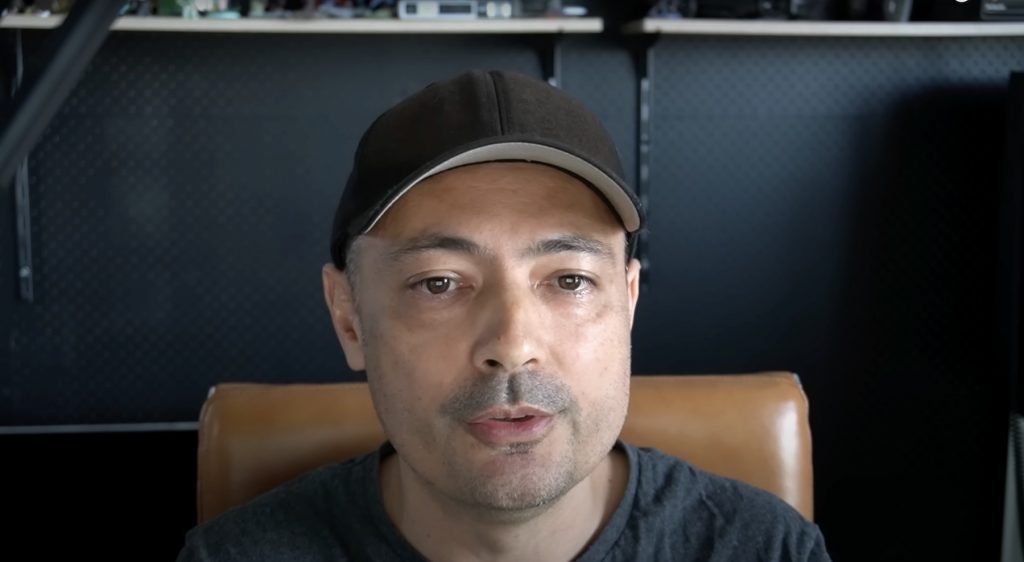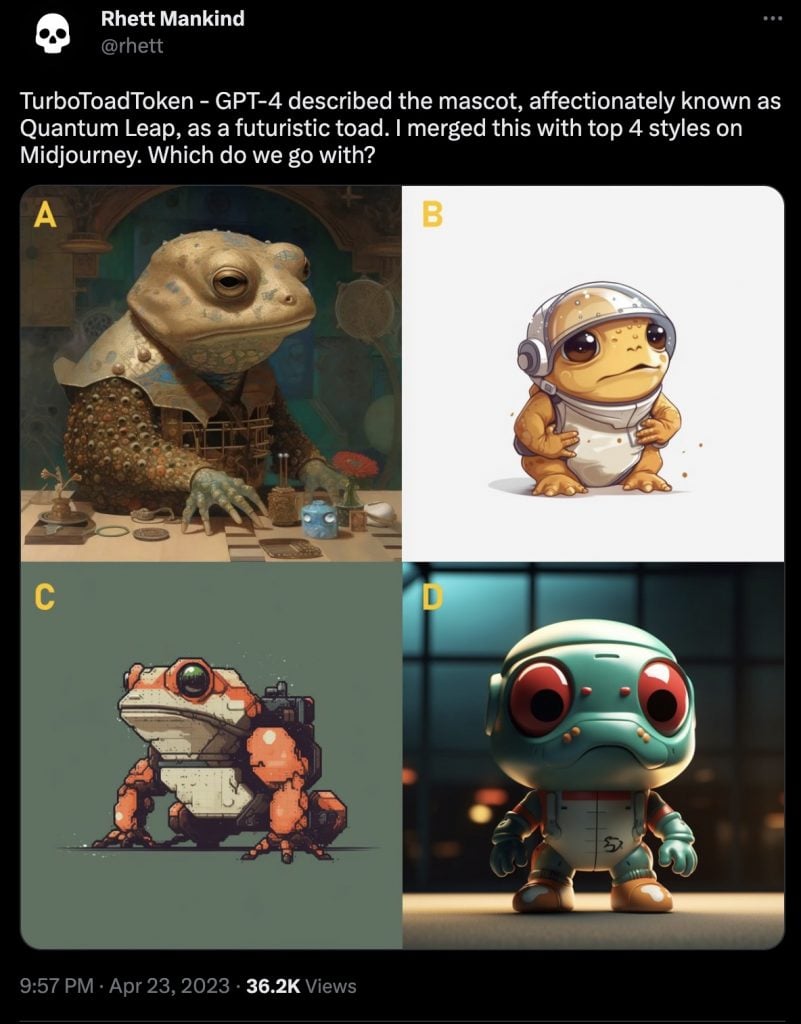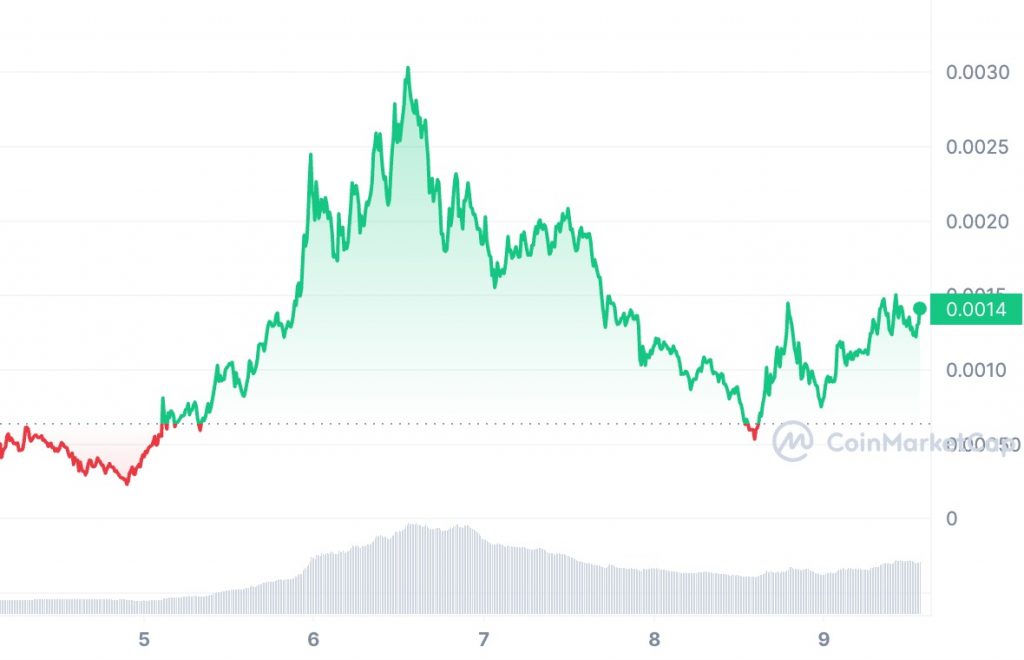NFTs
An Artist Asked ChatGPT How to Make a Popular Memecoin. The Result Is ‘TurboToad,’ and People Are Betting Millions of Dollars on It
Rhett Mankind began the project as a lark.

Rhett Mankind began the project as a lark.

Ben Davis

In the giant casino that is the internet economy, one artist put his chips on the squares labeled “ChatGPT” and “memecoin,” and hit the jackpot with a project called TurboToad.
Melbourne-based Rhett Mankind (real name: Rhett Dashwood) has worked in the digital art space for decades, eagerly joining the NFT world during its explosion. Earlier this year, his artwork was featured in Sotheby’s “Natively Digital” sale (it sold for €1,270, on an estimate of €6,000–8,000). More recently, Mankind has been doing marathon Twitter sessions where followers could send him their profile pictures and he would remake them in the styles of popular NFT artists like XCOPY and Beeple, using A.I. he had trained on their styles.
Despite Mankind’s hustle, the downturn in the NFT market has been punishing. “The digital art space has been really dead…,” Mankind said in a recent, emotional YouTube post. “This year has been really dead. I have really been struggling to get eyeballs on my art.”
Meanwhile, two other trends were in the air. First, the crypto markets have been seized by a fresh round of interest in so-called “memecoins.” These are novelty crypotocurrencies, often based on internet trends, that attract frenetic speculation (one, Pepecoin or $PEPE, was created on April 18, soaring to a $1.8 billion market cap on May 5 before falling).
Second, tech hype has moved from blockchain and the metaverse to generative A.I., and token markets have been flooded with new, often-dodgy currencies with “GPT” or “A.I.” themes, hoping to cash in.
Following Mankind’s projects making A.I.-generated Beeples and XCOPYs, he was thinking about how to do another work of “digital performance art” using Artificial Intelligence. The idea he hit upon as “sort of a joke” was to ask ChatGPT to instruct him how to launch a “successful memecoin” on a budget of $69.
Mankind posted to his Twitter followers that he would follow all of the steps the A.I. assistant gave him, documenting his journey as he went and letting them vote whenever there was a choice to be made.
And it worked.
I gave GPT-4 a budget of $69 and asked it to make the next great meme coin.
I will follow all instructions it gives me and document the process here.
Follow and participate 👇 pic.twitter.com/bBxkxkg7eS
— Rhett Mankind (@rhett) April 23, 2023
“This honestly started from inception with a curious idea I had the day before and a $20 subscription to ChatGPT, to a couple of weeks later reaching a market cap of $200 million,” Mankind told Artnet News via email. “It’s staggering.”
In the four days starting from April 23, Mankind used ChatGPT to provide him with the steps for launching a memecoin and then followed them: generating a coin name that would excite crypto-lovers (other options ChatGPT gave were “AstroCorgi” and “HypeHound”); writing and posting the TurboToad white paper; writing the code that would undergird the project; and launching the 69 billion tokens onto the blockchain, keeping 9 billion for himself.
Mankind used A.I. art generator Midjourney to create the token’s “TurboToad” mascot. His followers dubbed the creature “Quantum Leap.”

Screenshot of @Rhett’s Twitter post polling his followers about a mascot for TurboToad.
True, the artist blew through the original budget of $69 by hundreds of dollars, and relied on volunteers from his Twitter followers to check the A.I.-written code for errors. At one point, having run out of money, he turned to ChatGPT to suggest ways to fundraise, arriving at the idea of crowdfunding the project through exchanging donations for $TURBO tokens to get it off the ground.
“The initial crowdfund brought only 50 people, each providing from one dollar to a few hundred, willing to take a risk on what they thought might have a big return,” Mankind explained. But the attention attracted by his online performance, pinging off of the huge interest in stories about ChatGPT’s powers, served as an amplifier. As $TURBO started circulating, the project’s story attracted attention—and that attention, in turn, drew investors looking to trade the hype. “Now we have over 16,000 holders and many big whales (as they are called in crypto) trading hundreds of thousands back and forth.”
Speaking through tears in his YouTube account of project, Mankind explained his theory of what had made it work:
What helped is that I have been in this space for a while, and I have forged some sincere relationships with people I’ve never met, but built some trust. Because I’ve been grinding for so long. And because I’ve done some work in the crypto-art space, and people respect that, a lot of artists were supporting me, and a lot of artists had bought into the idea of this experiment or this performance art or whatever you want to call it. And they started retweeting it and telling people about it—just some other artists saying things, just “Isn’t this a cool idea? Doesn’t this spark inspiration or give you an idea hope?”
Before the Hail Mary explosion of interest inspired by his ChatGPT performance, Mankind said that he had been thinking of quitting art due to the brutal realities of the online creative economy:
I was so close to stopping doing art as well. It’s so hard. I can release as much as I like, but there’s no one interested. Now everyone is starting to bid on my artwork, and I am so thankful for those new collectors as well.
$TURBO trades at a fraction of a fraction of a cent—but with billions of tokens trading and hordes of global memecoin fans looking to bet on the hot new thing, the “market cap,” or total value of the tokens, has fluctuated wildly between $40 million and $250 million in the last few days, according to CoinMarketCap. That means that Mankind’s personal holdings of 9 billion $TURBO have likely swung between $5 million and $33 million—on paper at least, since he cannot sell them at once without affecting the price.
In the hyper-volatile memecoin market, $TURBO has already crashed once, peaking on May 6 before retracing some of the lost territory.

Screenshot of the $TURBO price history, via CoinMarketCap.
“Many people get caught up in the hype and don’t do their own research,” Mankind admitted, when asked about potential pitfalls ahead. “Some don’t realize this is a creative experiment, there’s no intrinsic value here, no team, no developers, no roadmap, just an idea expressed that a community of people has responded to.”
While supporters of Mankind have been fulsome in their praise for him as an artist, there is also no doubt that $TURBO is a vehicle for flippers. On the NFT Morning Show podcast on Monday, the hosts traded stories about getting in and out of $TURBO over the weekend, with one saying he put in 2 ETH (about $3,700) and got out 3.2 ETH (about $6,000).
Amid all the attention on $TURBO’s A.I.-assisted origin, another artist, Brooklyn-based Johnny Shankman, known as White Lights, posted a video on May 5 showing how it was possible to create a memecoin in under thirty seconds. After the video racked up close to 1 million views, crypto observers expressed alarm about the wave of scams potentially heading to market.
memecoin deploy% speedrun 27s ⏱️ pic.twitter.com/OYaXGb5ITR
— whitelights.eth ⌖ (🦇🔊) (@iamwhitelights) May 5, 2023
Digital artist Beeple, the best-known artist in the NFT art scene, dedicated his daily digital art post on May 4 to the image of a skyscraper-sized erect penis imagined as a space shuttle about to blast off, with the word “$TURBO” stamped on the launcher. Mocking the current memecoin frenzy, his caption joked that he was launching his own A.I. memecoin, Turboner, or $TRBNR.
Beeple wrote “this is definitely something we should decide to gamble on immediately… I mean given these circumstances is there even time at all to think?!?! AHHHHH. JUST SMASH THE BUY BUTTON AND PRAY TO BABY MARY PEPE JESUSS!!!!!!!”
Replies to Beeple’s tweet were flooded with memecoin investors demanding to know how they could buy into $TRBNR. At least one fake $TRBNR token also immediately sprang up.
aka $TRBNR (TURBONER™)
it’s the VERY FIRST AI memecoin based around today’s everyday that I finished 11 minutes ago so this is definitely something we should decide to gamble on immediately. yes, correct. 👌
I mean given these circumstances is there even time at all to…
— beeple (@beeple) May 4, 2023